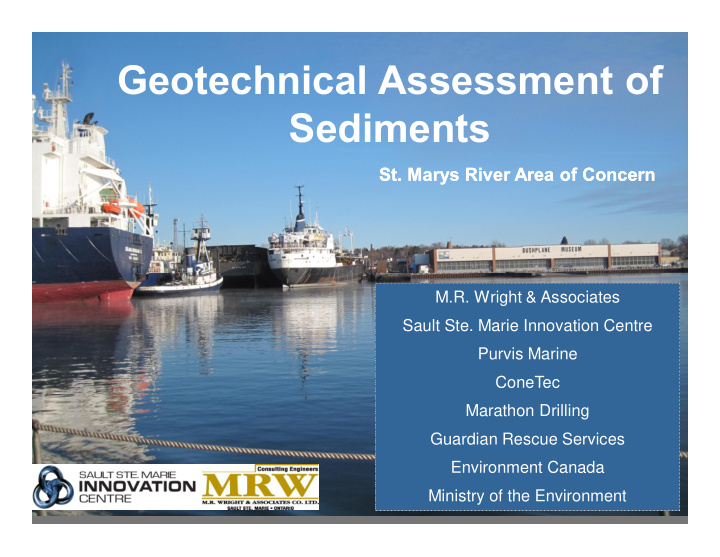



Geotechnical Assessment of Sediments St. Marys River Area of Concern St. Marys River Area of Concern M.R. Wright & Associates M.R. Wright & Associates Sault Ste. Marie Innovation Centre Sault Ste. Marie Innovation Centre Purvis Marine Purvis Marine ConeTec ConeTec Marathon Drilling Marathon Drilling Guardian Rescue Services Guardian Rescue Services Environment Canada Environment Canada Ministry of the Environment Ministry of the Environment
Remedial Action Plan
Background � Sediment assessments in the area east of Bellevue Park (2006- 2009) and Lake George Channel (2002-2009) down to 50 cm below the sediment-water interface revealed elevated levels of PAHs, petroleum hydrocarbons, oil and grease, and metals in the surficial sediments. � During these sampling events, woody debris and gas bubble generation with oil sheen was observed. � Application of the Canada-Ontario sediment decision-making framework, which considers sediment chemistry and benthic community impairment, indicated management actions are required at 7 sites in the are east of Bellevue Marine Park and 2 sites in Lake George Channel.
Sediment Cores Using a barge-mounted drill, collect sediment cores were to be collected for analysis of geotechnical and chemical properties, including: � Liquid limit, plastic limit, and plasticity index of soils � Grain size distribution � Unit weight � Water content � Organic contaminants (e.g., oil and grease, PAHs) � Trace metals (e.g., Cu, Pb, Zn)
Cone Penetration Test � The geotechnical field investigation included Cone Penetration Test (CPT) soundings in conjunction with an ultra violet induced fluorescence (UVIF) module. � In this test, a continuous steel core barrel was advanced into the sediment to delineate the following: � Sediment behaviour and physical engineering properties; � A vertical profile of hydrocarbon contamination; � Sediment (soil) types, and; � The sediment (soil) thickness above the native glacial till.
Study Area Sample location
St. Marys River
Results Organic Silt CPT Refusal Depth Station Water Depth (m) Thickness (m) (m) CS10 8.5 4.3 15.9 EC30 4.5 2.5 7.1 EC31 5.8 4.1 10.2 EC32 7.7 5.3 13.2 EC34 5.0 2.3 13.6 EC35 4.2 3.1 15.2 EC64 4.4 2.9 7.6
Conclusions The results from the CPT and core sampling have enabled us to better understand the sediment characteristics and water conditions. Specifically: � Water depths above sediment ranged from 4.2 to 8.5 m. � Below the sediment-water interface there exists a relatively thick and very soft organic sediment layer of 2.5 to 4.5 m. � Within this organic portion there exists a hydrocarbon profile, which tended to be greatest proximal to the sediment-water interface. � Below the organic sediment, between 7 and 15 m below the water surface, exists a more compact till layer (clay, sand, and silt).
Conclusions We also know that the collection of sediment cores in the St. Marys River is complicated by the extremely soft organic sediment. Future sampling efforts will need to employ a smaller diameter core sampler (e.g., 50 mm verses 130 mm), or alternative sampling method such as vibracoring.
Study Implications The presence of a relatively thick and very soft organic sediment layer (2.5 to 4.5 m) over a more compact till layer has significant implications for both capping and dredge material management approaches. � For dredging: soft unconsolidated sediments generate higher amounts of dredge residual that is difficult to dewater and is likely to cause a hydrocarbon sheen that will need to be managed. � For capping: a cap would need to be designed which incorporates placement of cap material in very thin layers that pre-load and consolidate the soft sediment with limited intermixing.
Acknowledgements This project has received funding support from the Government of Ontario. Such support does not indicate endorsement by the Government of Ontario of the contents of this material.
Recommend
More recommend